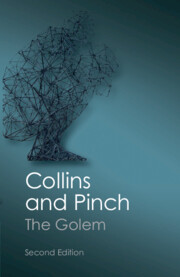Book contents
- Frontmatter
- Dedication
- Contents
- Preface to second edition
- Preface to first Canto edition
- Preface and acknowledgements
- Introduction: the golem
- 1 Edible knowledge: the chemical transfer of memory
- 2 Two experiments that ‘proved’ the theory of relativity
- 3 The sun in a test tube: the story of cold fusion 5
- 4 The germs of dissent: Louis Pasteur and the origins of life
- 5 A new window on the universe: the non-detection of gravitational radiation
- 6 The sex life of the whiptail lizard
- 7 Set the controls for the heart of the sun: the strange story of the missing solar neutrinos
- Conclusion: putting the golem to work
- Afterword: Golem and the scientists
- References and further reading
- Index
1 - Edible knowledge: the chemical transfer of memory
Published online by Cambridge University Press: 05 February 2014
- Frontmatter
- Dedication
- Contents
- Preface to second edition
- Preface to first Canto edition
- Preface and acknowledgements
- Introduction: the golem
- 1 Edible knowledge: the chemical transfer of memory
- 2 Two experiments that ‘proved’ the theory of relativity
- 3 The sun in a test tube: the story of cold fusion 5
- 4 The germs of dissent: Louis Pasteur and the origins of life
- 5 A new window on the universe: the non-detection of gravitational radiation
- 6 The sex life of the whiptail lizard
- 7 Set the controls for the heart of the sun: the strange story of the missing solar neutrinos
- Conclusion: putting the golem to work
- Afterword: Golem and the scientists
- References and further reading
- Index
Summary
Introduction
Everyone is fascinated by memory and nearly everyone feels that they would prefer their memory to be a little better. Memorising lines in a play, or memorising multiplication tables, is the kind of hard work that people like to avoid. The slow growth of experience that counts as wisdom seems to be the gradual accumulation of memories over a lifetime. If only we could pass on our memories directly we could use our creative abilities from an early age without needing to spend years building the foundations first.
Between the late 1950s and the mid-1970s it began to look as though one day we might be able to build our memories without the usual effort. This was as a result of experiments done by James V. McConnell and, later, Georges Ungar, on the chemical transfer of memory in worms and rats. If memories are encoded in molecules then, in principle, it should be possible to transfer The Complete Works of Shakespeare to memory by ingesting a pill, to master the multiplication tables by injection into the bloodstream, or to become fluent in a foreign language by having it deposited under the skin; a whole new meaning would be given to the notion of ‘swallowing the dictionary’. McConnell and Ungar believed they had shown that memories were stored in chemicals that could be transferred from animal to animal.
- Type
- Chapter
- Information
- The GolemWhat You Should Know About Science, pp. 5 - 26Publisher: Cambridge University PressPrint publication year: 2012
- 1
- Cited by



